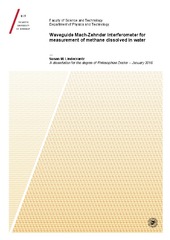Waveguide Mach-Zehnder interferometer for measurement of methane dissolved in water
Permanent link
https://hdl.handle.net/10037/9236View/
Thesis entire (PDF)
Lindecrantz SM, Hellesø OG. Estimation of propagation losses for narrow strip and rib waveguides. Also available in IEEE Photonics Technology Letters 2014, vol. 26, no. 18 (PDF)
Lindecrantz SM et al. Characterization of a waveguide Mach-Zehnder interferometer using PDMS as a cover layer. Also available in Journal of the European Optical Society - Rapid publications, 2015, vol. 10 (PDF)
Dullo FT, Lindecrantz SM et al. Sensitive on-chip methane detection with a cryptophane-A cladded Mach-Zehnder interferometer. Also available in Optics Express 2015, vol. 23, no. 24 (PDF)
Date
2016-04-25Type
Doctoral thesisDoktorgradsavhandling
Author
Lindecrantz, Susan M.Abstract
In this dissertation, we present the development of a novel, compact and highly sensitive waveguide Mach-Zehnder interferometer to measure methane dissolved in water. Methane is a greenhouse gas, like carbon dioxide, and is emitted from both natural sources and human activities. Due to the challenges to measure dissolved methane in the sea and the vast area it covers, much of the methane cycle is unknown. In the last couple of years, there has been an up-swing in the development of subsea methane sensors. These high-end sensors rely on successfully separating the dissolved gas from the water with a membrane before the measurements, effecting the limit of detection, response time and it may give rise to hysteresis effects. Alternatively, samples can be transported to an on-shore laboratory, which can be time-consuming and expensive.
We developed a methane sensor with the possibilities of direct and in-situ detection of methane with a relatively cheap and compact optical sensor-chip. A methane sensitive layer, consisting of a host-polymer and cryptophane-A, is deposited onto the chip. Cryptophane-A is a supra-molecular compound that can entrap methane molecules within its structure and thus, induce a change in the refractive index of the host-polymer. This change is detected by the evanescent field from the waveguide, in the sensing arm of the interferometer. Thus, with a change in refractive index in the sensitive layer, a phase change between the reference and the sensing arms of the interferometer is obtained.
For obtaining optimal design, simulations were made for shallow silicon nitride rib waveguides with respect to the sensitivity as function of refractive index and the mode-behaviour of the waveguide. Once the design had been established, the waveguides were fabricated externally, with a core thickness of 150 nm, a rib height of 5 nm, rib widths of 1.5, 2 and 3 μm and sensing lengths of 1, 2 and 3 cm. The propagation losses were measured and simulated for tantalum pentoxide (similar to silicon nitride) strip and rib waveguides, to find the dependence of the propagation losses on the waveguide width. The sensitivity of the sensor was characterised with a diluted acid (HCl) and, in a separate measurement, by changing the temperature of the sensor coated with a polymer (PDMS).
The sensor was combined with a methane sensitive layer of styrene acrylonitrile (SAN) and cryptophane-A, to detect methane gas. The sensitive layer showed a 17-folded sensitivity increase with a cryptophane-A to SAN ratio of 1:9. Methane gas was measured in the range of 300 ppm to 4.4%(v/v), with a detection limit of 17 ppm. Finally, the sensor was tested with methane in water. It was found that when the sensitive layer was exposed to water, the SAN polymer showed fractures along the surface. In an effort to circumvent the problem, a protecting layer of PDMS was deposited directly onto the SAN layer. However, after some time bubble structures appeared within the layer after exposure to water. Despite this, dissolved methane was successfully and repeatedly detected for concentration in range 9 to 46 μM. A detection limit of 49 nM was obtained, showing that the sensor is suitable for measurements of methane dissolved in water.
Publisher
UiT Norges arktiske universitetUiT The Arctic University of Norway
Metadata
Show full item recordCollections
Copyright 2016 The Author(s)
The following license file are associated with this item:


 English
English norsk
norsk
